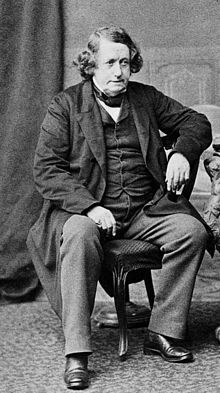Hugh Falconer
Hugh Falconer (born February 29, 1808 in Forres , Scotland , † January 31, 1865 in London ) was a Scottish paleontologist , botanist and geologist . Its official botanical author abbreviation is “ Falc. "
Live and act
Hugh Falconer studied in Aberdeen and Edinburgh ; In 1830 he went to India as an assistant doctor . In India he became superintendent of the botanical garden in Saharanpur in 1832 . Here he began a paleontological investigation of the Siwaliks Mountains (in today's Nepal ) and brought together a rich collection of fossil mammal remains with the paleontologist Proby Thomas Cautley . He also studied the Himalayas in botanical terms and contributed to the introduction of tea in England. In 1837 he accompanied a second expedition to Kabul and visited many areas of this region, including those around Kashmir , as well as the great glaciers of the Karakoram . In 1842 he returned to England for health reasons and published several papers on the fossil fauna of the Siwaliks Mountains and the fossil remains of the island of Perim in the Bab al-Mandab strait off Yemen .
He played a role in the excavations at Kents Cavern , which played an important role in prehistoric archeology.
Falconer's greatest work is the Fauna antiqua Sivalensis (1846–49, 9 parts) edited with Cautley . In 1848 Falconer became director of the botanical garden in Kolkata ( Haora ) and professor of botany at the Medical College . In 1850 he visited the province of Tenasserim to study the teak forests . Returning to England in 1855, he devoted himself particularly to the study of fossil cave fauna and published On the species of Mastodon and Elephant and in 1860 a treatise on the bone caves on the Gower Peninsula in South Wales . He has also explored the caves in Italy and Gibraltar .
His estate, Palaeontological memoirs and notes (London 1868, 2 vols.), Was edited by the paleontologist Roderick Impey Murchison .
Honors
In honor of Falconer, the screw goat bears the scientific name Capra falconeri . The genus Falconeria Royle from the milkweed family (Euphorbiaceae) was also named after him.
Individual evidence
- ↑ Lotte Burkhardt: Directory of eponymous plant names . Extended Edition. Botanic Garden and Botanical Museum Berlin, Free University Berlin Berlin 2018. [1]
Web links
- Author entry and list of the described plant names for Hugh Falconer at the IPNI
- The Friends of The Falconer Museum
| personal data | |
|---|---|
| SURNAME | Falconer, Hugh |
| BRIEF DESCRIPTION | Scottish paleontologist, botanist and geologist |
| DATE OF BIRTH | February 29, 1808 |
| PLACE OF BIRTH | Forres , Scotland |
| DATE OF DEATH | January 31, 1865 |
| Place of death | London |
